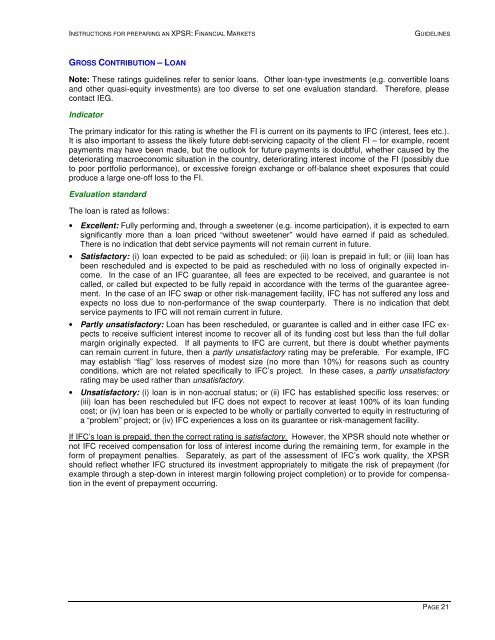Guidelines - IFC
Guidelines - IFC
Guidelines - IFC
You also want an ePaper? Increase the reach of your titles
YUMPU automatically turns print PDFs into web optimized ePapers that Google loves.
INSTRUCTIONS FOR PREPARING AN XPSR: FINANCIAL MARKETS<br />
GUIDELINES<br />
GROSS CONTRIBUTION – LOAN<br />
Note: These ratings guidelines refer to senior loans. Other loan-type investments (e.g. convertible loans<br />
and other quasi-equity investments) are too diverse to set one evaluation standard. Therefore, please<br />
contact IEG.<br />
Indicator<br />
The primary indicator for this rating is whether the FI is current on its payments to <strong>IFC</strong> (interest, fees etc.).<br />
It is also important to assess the likely future debt-servicing capacity of the client FI – for example, recent<br />
payments may have been made, but the outlook for future payments is doubtful, whether caused by the<br />
deteriorating macroeconomic situation in the country, deteriorating interest income of the FI (possibly due<br />
to poor portfolio performance), or excessive foreign exchange or off-balance sheet exposures that could<br />
produce a large one-off loss to the FI.<br />
Evaluation standard<br />
The loan is rated as follows:<br />
• Excellent: Fully performing and, through a sweetener (e.g. income participation), it is expected to earn<br />
significantly more than a loan priced “without sweetener” would have earned if paid as scheduled.<br />
There is no indication that debt service payments will not remain current in future.<br />
• Satisfactory: (i) loan expected to be paid as scheduled; or (ii) loan is prepaid in full; or (iii) loan has<br />
been rescheduled and is expected to be paid as rescheduled with no loss of originally expected income.<br />
In the case of an <strong>IFC</strong> guarantee, all fees are expected to be received, and guarantee is not<br />
called, or called but expected to be fully repaid in accordance with the terms of the guarantee agreement.<br />
In the case of an <strong>IFC</strong> swap or other risk-management facility, <strong>IFC</strong> has not suffered any loss and<br />
expects no loss due to non-performance of the swap counterparty. There is no indication that debt<br />
service payments to <strong>IFC</strong> will not remain current in future.<br />
• Partly unsatisfactory: Loan has been rescheduled, or guarantee is called and in either case <strong>IFC</strong> expects<br />
to receive sufficient interest income to recover all of its funding cost but less than the full dollar<br />
margin originally expected. If all payments to <strong>IFC</strong> are current, but there is doubt whether payments<br />
can remain current in future, then a partly unsatisfactory rating may be preferable. For example, <strong>IFC</strong><br />
may establish “flag” loss reserves of modest size (no more than 10%) for reasons such as country<br />
conditions, which are not related specifically to <strong>IFC</strong>’s project. In these cases, a partly unsatisfactory<br />
rating may be used rather than unsatisfactory.<br />
• Unsatisfactory: (i) loan is in non-accrual status; or (ii) <strong>IFC</strong> has established specific loss reserves; or<br />
(iii) loan has been rescheduled but <strong>IFC</strong> does not expect to recover at least 100% of its loan funding<br />
cost; or (iv) loan has been or is expected to be wholly or partially converted to equity in restructuring of<br />
a “problem” project; or (iv) <strong>IFC</strong> experiences a loss on its guarantee or risk-management facility.<br />
If <strong>IFC</strong>’s loan is prepaid, then the correct rating is satisfactory. However, the XPSR should note whether or<br />
not <strong>IFC</strong> received compensation for loss of interest income during the remaining term, for example in the<br />
form of prepayment penalties. Separately, as part of the assessment of <strong>IFC</strong>’s work quality, the XPSR<br />
should reflect whether <strong>IFC</strong> structured its investment appropriately to mitigate the risk of prepayment (for<br />
example through a step-down in interest margin following project completion) or to provide for compensation<br />
in the event of prepayment occurring.<br />
PAGE 21
















